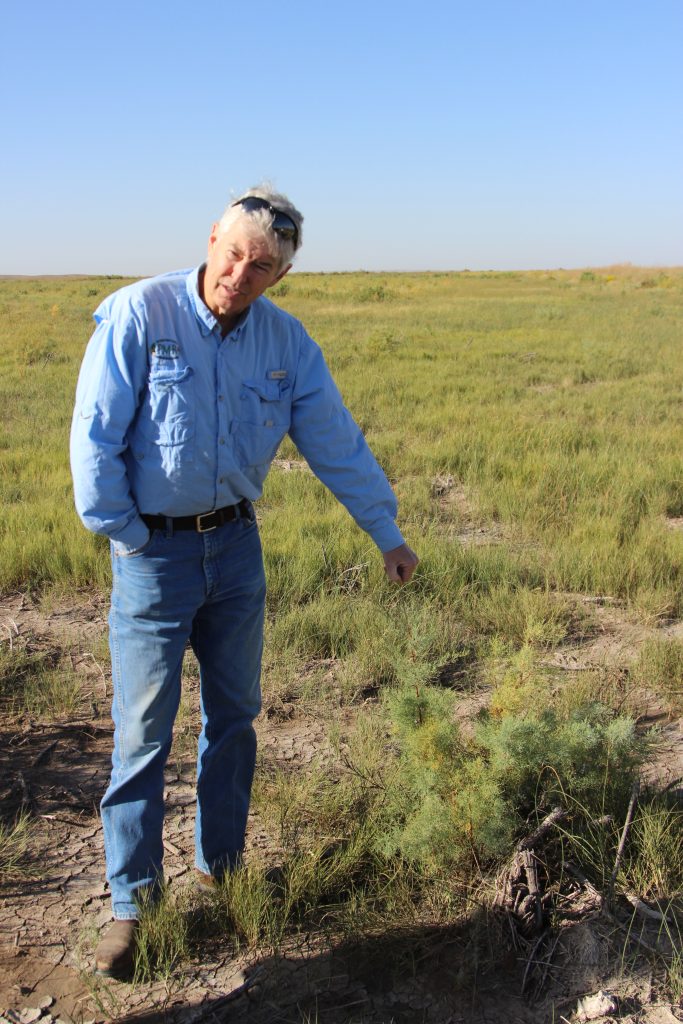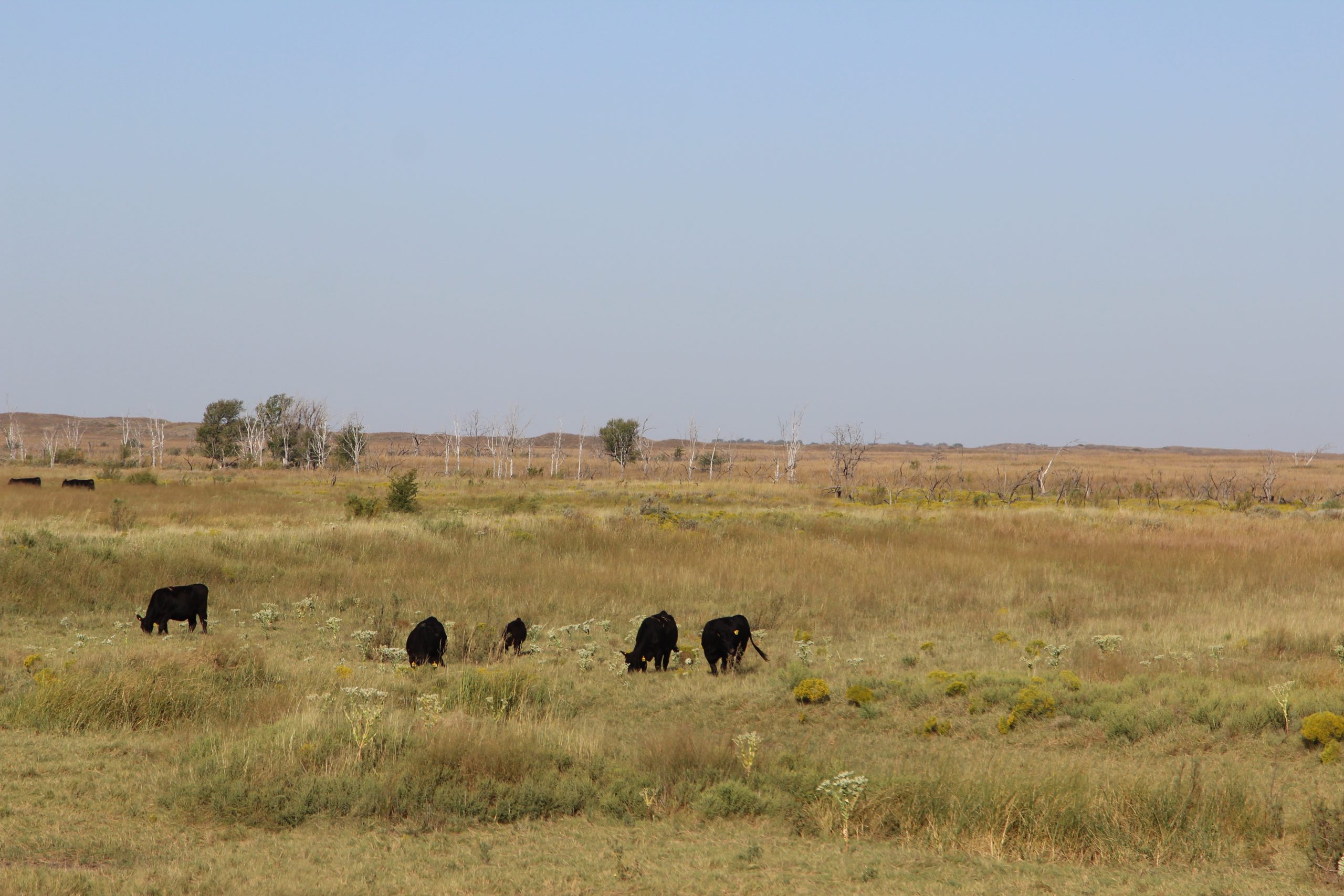Private capital can help ranchers to build habitat for an endangered bird, improve their ranchland and earn added income.
That approach is working to preserve habitat for lesser prairie-chicken. The only way to build its population is to preserve and restore the best habitat, experts say. Wayne Walker, principal of Common Ground Capital, near San Angelo, Texas, has been an advocate of the bird, but also for ranchers, who need quality rangeland to raise cattle. He believes ranchers need a significant financial incentive with an up-front capital investment helping the rancher’s cash flow to make it work. With a common-sense approach, the birds and ranchers win, he believes.
That model was on display when Walker recently showcased his program on 20,000 acres known as the Dunne Ranch, which is part of the Gardiner Ranch in Ashland, Kansas, in Clark County, just north of the Oklahoma border.
The lesser prairie-chicken is on the endangered species list, but the U.S. Fish and Wildlife Service can certify credits that provide incentive to a landowner like Mark Gardiner and his family, who are nationally known for their Angus cattle operation.
Around 1900, there were estimates of about a million lesser prairie-chickens. There are an estimated 25,000 to 30,000 birds in the USFWS’s Northern Distinct Population District, and biologists believe most of them are located in just a few remaining strongholds. In Kansas, besides Clark County, Scott and Gove counties also have more birds thanks to habitat conservation efforts.
Walker sells conservation credits through energy developers for market-based easements to landowners. A Colorado wind energy company will purchase the new credits that are used to preserve the Kansas habitat. Colorado also has lesser prairie-chickens, but numbers have dwindled, and an easement in Kansas can still help with the mission.
Mark Gardiner remembered the first time he met Walker, about 10 years ago, and they had a friendly conversation, but he asked Walker to come back 30 days later.

Gardiner’s main concern was if he signed an agreement he wondered if he could he face restrictions in how he and his family operated the ranch in the future.
Walker, whose family has a ranch in Texas, came back a month later and said he understood Mark’s concerns and assured him that the approach to finance the transaction by Common Ground Capital works. Habitat improvement adds value to the rangeland to support more cattle, which can help the Gardiners to expand. The conservation bank pays the landowner for a permanent easement.
Gardiner said the partnership works because he believes farmers and ranchers have a vocation to feed the world, and it is not one he and his brother, Greg, take lightly.
“If we don’t feed the world, there is no ecosystem,” Mark Gardiner said. “Humans are a part of the ecosystem, too.”
Incentives part of the process
The agreement means the Gardiner family will receive a substantial portion of payments of $2,500 an acre credits. The payments help to maintain a long-term endowment on the land, Walker said, and provide a large, up-front payment to help the Gardiner family with building their ranch for future years.
Ranching in southwest Kansas is not easy. On a warm October day, Mark Gardiner took a few minutes from sorting cattle on horseback to talk about the past 10 years that included the Starbuck Fire in March 2017 that killed many cattle and wildlife. It also burned homes and scorched rangeland.
One benefit from the Starbuck Fire was that it eliminated salt cedar and other trees that lesser prairie-chickens strongly avoid, while also providing his family a rare opportunity to restore the landscape basically from scratch, he said. That included habitat improvement to help the lesser prairie-chicken and improving grass conditions to support grazing cattle.
In 2024, the commitment shows, he said.
“This year was as good a year as we’ve ever had after all the rains,” he said.
The southwest Kansas rancher has an affinity for the lesser prairie-chickens. Gardiner sees more lesser prairie-chickens, and that is a sign the restoration process works.
Tailor made
Stephanie Manes, a wildlife biologist and prairie ecosystem specialist who has consulted with Walker and his team for 11 years, said each ecosystem has its own needs. The lesser prairie-chicken eats insects, including grasshoppers, and in the winter, they also eat weed seeds, forbs and the tips of sagebrush. She noted that prairie restoration also improves habitat for other declining species like the monarch butterfly, a beloved migratory insect and pollinator that depends entirely on native milkweed. When this milkweed is properly managed with mid-summer prescribed fire, the returning monarchs can complete their journey to Mexico for the winter. “Maintaining enough fresh re-growth of flowering milkweed in the southern Plains during late summer is key,” she said. “By then, most milkweed plants are either grazed down or dried up for the season when migrating monarchs most need both the nectar and one more generation of eggs to succeed.”
The Gardiners’ ranchland is a large enough tract to provide a natural habitat stronghold, Walker said.
“Only about 20% of the native mixed-grass prairie remains from the landscape 150 years ago,” Manes said. What few large blocks remain are severely fragmented with invasive trees, roads, powerlines, energy development and other human structures.
“Opportunities to expand that landscape in a significant way are very rare, but the work of the Gardiner family, Walker and others shows what can happen with the right combination of a natural reset, investment capital, credit sales with companies needing mitigation credits and a group commitment to maintain the restored prairie in perpetuity,” she said. “That outcome requires real, up-front money to ranchers and long-term endowments to maintain the land. … Short-term annual incentive payments simply aren’t enough.”
Partnership at work
The private partnership is an example of what can be done with meaningful private sector incentives. Credit sales aren’t guaranteed, especially if the chicken is removed from the endangered species list. With outside investment, Common Ground Capital can shoulder the risk of restoration because most ranchers would not take the risk on their own, Walker said.
His formula works in other Kansas regions where there is a stronghold of lesser prairie-chickens in Scott and Gove counties.
Manes also noted the landowner needs to be able to make a profit, and improved range quality and conservation easement payments provide dependable cash flow for future needs.
What Walker likes about the conservation credits is that, unlike annual incentive payments, they provide a large, one-time revenue event for ranchers who can spend or reinvest the money however they see fit. “It’s no different than selling land, only in this case, ranchers get to keep the land and cattle and have all the long-term pasture management costs covered, too. The U.S. Department of Agriculture offers programs like Environmental Quality and Incentives Program and Conservation Reserve Programs, but they are not always sustainable because they are temporary contracts and subject to regulatory restrictions or reimbursement rates set by Congress.”
To restore a prairie foothold is a long-term process that needs to reward a landowner over many years, he said.
Plus, some landowners are uneasy with the Endangered Species Act, Walker said.
Since Walker’s program is certified by the U.S. Fish and Wildlife Service, the Habitat Conservation Plan provides certainty.
In the case of ranchland, the habitat is preserved and creates a way for a farmer and rancher to continue his family’s legacy and preserve it into future generations, Manes said and Walker agreed.
“The lesser prairie-chicken is a harbinger of the prairie,” Walker said.
Dave Bergmeier can be reached at 620-227-1822 or [email protected].

Salt cedars no friend to ranchers
By Dave Bergmeier
Salt cedar trees ability to quickly spread and drink precious water supplies make them a tough foe for many landowners.
Wayne Walker, principal of Common Ground Capital, San Angelo, Texas, and his team have stayed the course to put resources in place to eliminate as many of them as they can. During an Oct. 2 tour on the Gardiner Ranch near Ashland in Clark County, Kansas, he showed where salt cedars, an invasive species, once thrived. An invasion reduces forage availability and quality for livestock.
“A salt cedar is a thorn in our side,” Walker said.
Stephanie Manes, who consults with Walker and his team and is a wildlife biologist and prairie ecosystem specialist based in Manhattan, said the salt cedar can consume as much as 10 gallons of water a day. She showed a spot along the Cimarron River where the water flow was virtually non-existent because of the infestation of salt cedars. The trees are a bane for lesser prairie-chicken habitat. The birds prefer grass for protection and food. One of the benefits is improved grass and better forage, which is an added incentive for ranchers.
To kill the salt cedars, she said aerial drones can be programmed with artificial intelligence to efficiently and accurately apply herbicides.
Walker, who oversees much of the work, said it is time-consuming because the species is relentless. Untreated, the salt cedars can take over the prairie again in just a few years.
“We can get it restored,” Walker said. “It does come at a great expense, but eventually it pays off.”
Dillon Hilton, president of Blue Sage Services LLC, Beaver, Oklahoma, coordinates with Walker and the Gardiners about tree removal.
“You have to have a good management plan,” he said, and the restoration process has worked well.
Blue Sage Services has been eradicating the salt cedars, and it is rigorous work that is beneficial.
“The salt cedar is not much of a tree,” Hilton quipped. “You have the choice of a natural species like the lesser prairie-chicken and ranching or an invasive bush.”
During a work day, Stacey Shyrock with Blue Sage Services described the process. He said the Caterpillar D-6T dozer uses tracks instead of tires to reduce ruts. It pulled a RanchWorx roller chopper, which is capable of running six days a week. The steel tines on the rollers aerate the soil, too, which helps grass grow, he said.
Walker estimated the cost to run the equipment was about $75 per acre, which can add up quickly when the machine is needed to cover about 6,000 acres. But because prairie chickens strongly avoid tall trees in a one-third-mile radius, as a compromise, Walker said native cottonwood trees can remain standing in strategic, limited places to provide cattle with shade from the summer’s heat.
“There is a need for trees to provide cool shade, so that is the give and take negotiation with the landowner,” he said. “Sometimes, it comes down to the question, is this one cottonwood tree worth $25,000?”
There is a shared responsibility, Gardiner said, because his family is committed to cattle and rural lifestyle.
Dave Bergmeier can be reached at 620-227-1822 or [email protected].



